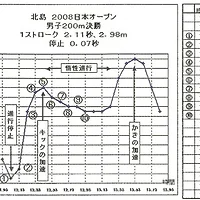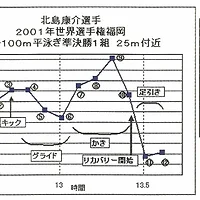2 BREASTSTROKE TECHNIQUES AND 3 KEY TIMING TIPS
2가지 평영 기술과 3가지 타이밍 핵심 팁
Courtesy of Gary Hall Sr., 10-time World Record Holder, 3-time Olympian, 1976 Olympic Games US Flagbearer and The Race Club co-founder.
Breaststroke is the most inefficient and slowest of the four strokes. It is also the key to a successful IM. It is also the one stroke that seems to come and go like the wind, and is perhaps the most challenging to master. How can a swimmer do so well at breaststroke one season, only to find that he or she is struggling to approach the same times the next season? It is all about timing.
평영은 4대 영법 중 가장 비효율적이고 느리다. 또한 개인혼영 성공의 열쇠이기도 하다. 또한 한 번의 스트로크는 바람이 오가는 것과 같아 보이며, 아마도 습득하기 가장 어려울 것이다. 어떻게 수영 선수는 평영을 한 시즌에 그렇게 잘 할 수 있는지, 그녀가 다음 시즌 같은 시간에 근접하기 위해 몸부림치는 것에서 찾을 수 있지 않을까? 그것은 타이밍이다.
When ESPN did a study on Rebecca Soni’s stroke they found that her kick provided around 100 lbs of propulsive force, while her pull provided about 20 pounds of propulsive force. While not many have the propulsion in the legs of Rebecca, the truth is that most of the propulsion from all good breaststrokers comes from the legs, not the arms. The key to a fast breaststroke is to develop a strong kick and to reduce frontal drag after the kick.
ESPN에서 레베카 소니의 영법을 연구 했을 때, 그녀가 발차기로 100 lbs의 추진력을 생성하고, 팔 돌리기로 20 파운드의 추진력을 내는 것을 확인했다. 레베카의 다리에 추진력은 크지 않지만, 사실 모든 좋은 평영 영자의 추진력의 대부분은 손이 아니라 다리에서 나온다. 빠른 평영의 열쇠는 강력한 발차기를 개발하는 것과 발차기 후에 정면 저항을 줄이는 것이다.
In the world, there are lumpers and splitters. Splitters would say that there are many different breaststroke techniques that are effective, each one perhaps having some subtle difference from another. As a lumper, I consider that there are two distinctively different breaststroke techniques today; the fast arm-recovery and the delayed arm-recovery technique. All of the elite breaststrokers of the world use some variation of these two techniques and the majority of them use the former.
세계에는 병합파 들과 세분파 들이 있다. 세분파 들은 다양한 평영 기술이 있는 것은 그것이 효과적이라는 것이고, 각각의 하나는 아마도 서로 미묘한 차이를 가지고 있다고 말한다. 병합파를 고려해서 두 개의 완전히 다른 평영 기술이 있다는 것을 오늘 보여주겠다; 빠른 팔 되돌리기와 지연된 팔 되돌리기 기술이다. 세계의 모든 엘리트 평영 영자들이 이 두 기술을 일부 변형해 사용하고 그 중 대부분은 전자를 사용한다.
The fast arm-recovery breaststrokers (Peaty, Cordes, Meilutyte) do precisely that. They get their hands quickly through the pull cycle, snapping the elbows downward and then pushing the hands forward over the surface into a streamline before the kick propulsion takes place. The delayed arm-recovery breaststrokers (Soni, Gyurta, Larson) either never drop the elbows on the pull and bring the elbows further back behind the chest, recovering with most of the forearm over the water (Soni) or slow the hands above the water before pushing them forward into the frontal streamline (Gyurta, Larson). The advantage of the fast arm recovery is that the swimmer gets a little more power out of the pull by pushing the elbows down and accelerating the hands through the pull cycle. The advantage of the delayed recovery is that it reduces frontal drag on the recovery by elevating most of the forearm out of the water (Soni) and augments the coupling effect on the kick by adding the kinetic energy of the arms moving forward to the pressing upper body and head energy (Soni, Larson and Gyurta).
빠른 팔 되돌리기 평영 영자들(애덤 피티, 루타 메일루팃)은 정확하게 그렇게 한다. 그들은 팔 돌리기 사이클에서 손을 빠르게 가져가며, 팔꿈치를 아래로 스냅을 준 다음에 발차기로 추진력을 내기 전에 유선형 자세로 수면에 걸쳐 손을 앞으로 민다. 지연된 팔 되돌리기 영자들(레베카 소니, 다니엘 죳따)은 누구도 당기며 팔꿈치를 떨어트리거나 가슴뒤로 팔꿈치리를 가져가지 않으며, 정면 유선형으로 앞으로 밀기 전에 천천히 손을 물 위로 (다니엘 죳따)하거나 대부분의 팔뚝을 물 위로 넘겨 리커버리한다. 빠른 팔 리커버리의 이점은 당기는 주기를 통해 손을 가속하고 팔꿈치를 아래로 당기는 것으로 영자가 당기기로 인해 힘을 좀 더 얻을 수 있다는 것이다. 지연된 리커버리의 이점은 팔을 앞으로 움직이는 운동에너지에 상체와 머리 에너지를 추가함으로서 발차기에 커플링 효가를 증가시키는 것(레베카 소니, 다니엘 죳따)과 대부분의 팔뚝을 물밖으로 들이올림으로서(레베카 소니) 리커버리에서 정면 저항을 감소시키는 것이다.
With either technique, the timing of all motions is critical. During the pull, in order to reduce frontal drag, the hips and legs need to be near horizontal with the surface with the feet pointed (plantar flexed), while the upper body elevates to the highest point possible. That elevation requires full extension of the lumbar spine. The higher the elevation of the upper body and head, the more kinetic energy can be created in the press forward. Gravity and core strength have a lot to do with developing that energy on the way down. Some, like Peaty, press forward with tremendous force and speed to augment the power of the kick. In order for that upper body energy to couple maximally with the kick, the most powerful moment of force from the kick must occur precisely when the kinetic energy of the upper body is greatest. The most powerful moment of force from the kick occurs just after the feet begin moving backward and the moment of greatest kinetic energy from the upper body occurs just as the shoulders strike the water. In order for these two events to coincide, there is precious little time to get the legs up under the body in position to initiate the kick prior to the shoulders entering the water. Further, with both thighs pulled forward under water, the body's drag coefficient goes off the charts, so it is in the best interest of the swimmer to not remain in that position any longer than necessary. For these two reasons, one sees all elite breaststrokers get through the kick cycle extremely fast, pulling the legs forward quickly to minimize time in that position and pushing the feet back quickly to generate more propulsion. When observing the speed of the legs of an elite breaststroker from above, all one sees is a blur, like the twitch of a frog leg.
어느 기술에서도, 모든 동작의 타이밍은 중요합니다. 당기기를 하는 동안, 전면 저항을 줄이기 위해, 상체가 가능한 가장 높은 지점에 올라올 때, 엉덩이와 다리는 발을 펴고(발바닥이 구부러진) 수면에 가깝게 수평해야합니다. 그 상승은 요추의 완전한 확장이 필요합니다. 상체와 머리의 상승이 높을수록 더 많은 운동 에너지가 앞으로 누르도록 만들 수 있습니다. 중력과 코어 근력은 내리막 길의 에너지 개발을 많이 돕습니다. 일부는, 피티처럼, 발차기의 힘을 늘리기 위해 엄청난 힘과 속도로 앞으로 누릅니다. 발차기와 최대한 연결하기 위한 상체 에너지를 위하여, 발차기로부터 가장 강력한 힘을 내는 순간은 상체의 운동 에너지가 가장 큰 때에 바로 발생합니다. 발차기로부터 가장 강력함 힘을 내는 순간은 발이 뒤로 움직임을 시작한 직후에 발생하고 상체로 부터 가장 큰 운동 에너지를 내는 순간은 어깨가 물을 때리는 것처럼 발생합니다. 이 두 일들을 맞추기 위해, 어깨가 물에 들어가기 전에 발차기를 시작하는 위치의 몸 아래에 조력을 얻을 수 있는 귀중한 시간이 조금 있습니다. 게다가, 양쪽 허벅지를 물 속에서 앞으로 당기므로, 신체의 저항 계수는 차트에서 나빠지며, 그래서 필요 이상으로 길게 그 위치에 머무르지 않는 것은 선수들의 최대 관심사입니다. 이 두가지 이유로, 모든 엘리트 선수는 극도로 빠른 발차기 주기를 갖는 것을 볼 수 있고, 그 위치에 있는 시간을 최소화하기 위해 앞으로 빠르게 다리를 당기고 추진력을 더 생성하기 위해 발을 뒤로 빠르게 밉니다. 위에서 엘리트 평영 영자의 다리 스피드를 관찰할 때, 개구리 다리를 잡아당기는 것 처럼 모두 하나로 표시되는 것은 흐릿함입니다.
The second timing issue with breaststroke is the initiation of the pull cycle. Often, breaststrokers begin the pull too early, during the moment of the most powerful force from the kick. If the hands separate out front too soon, then the drag coefficient goes up again and the force of the kick is wasted on a bad body position. It is critical that the breaststroker be patient enough to benefit from their kick during the strike phase by having the chin down nearly touching the chest under water, the hands held together out front and the shoulders pushed forward as far as possible. However, if the breaststroker holds in this position too long, reducing the stroke rate, then the body decelerates too much after the kick before the initiation of the next pull. There is very little margin of error between initiating the pull too soon or too late. Of course, the shorter the race, the higher the stroke rate.
The third timing issue in breaststroke is on the arm recovery. By delaying the recovery of the arms, the mass of the arms moving forward is added to the mass of the upper body and head to increase kinetic energy for coupling with the kick. With this technique, the hands must get into the propulsive phase of the pull quicker, once they are in the streamline in front, so there is little time spent there. With the fast arm recovery, the arms are already in the streamlined position before the kick propulsion takes place, so no coupling can occur, and they remain there longer before initiating the pull. Many breaststrokers using this technique (Cordes, Peaty) will snap the head down, rather than lay the head down, to increase kinetic energy from the head (which weighs around 12 pounds).
Because the timing of breaststroke is so sensitive, it lends itself to doing drills more than any other stroke. At The Race Club, we practice many breaststroke drills working on the fundamentals of a strong kick, great streamlining and perfect timing for all motions.
평영의 타이밍은 매우 감각적이기 때문에, 다른 어떤 영법보다 연습을 더 많이 해야 한다. 우리는 강력한 발차기를 기초로 하거나, 훌륭한 유선형자세와 모든 동작에 완벽한 타이밍을 맞추는, 등을 하는 많은 평영 드릴을 연습한다.
'Swimming > 평영' 카테고리의 다른 글
| [번역]스위밍 스마트 평영 10 흥미로운 여중생 선수의 예 (0) | 2016.03.09 |
|---|---|
| [번역]스위밍 스마트 평영 09 기록 향상을 전략적으로 생각 (0) | 2016.03.09 |
| [번역]스위밍 스마트 평영 08 평영 발차기 (0) | 2016.02.16 |
| [번역]스위밍 스마트 평영 07 평영 "풀"의 기술 (0) | 2016.02.16 |
| [번역]Speedo Pace Club Tutorials - Breastroke (0) | 2016.02.14 |



